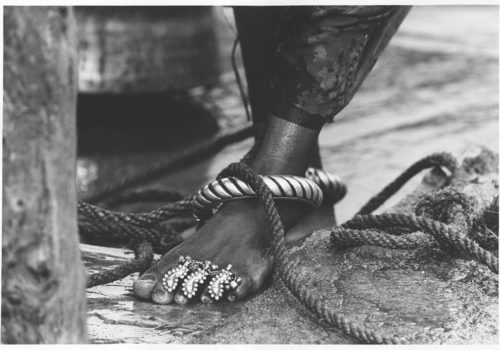Gianni Berengo Gardin was fascinated by Mahatma Gandhi while still at school. When he had an opportunity to travel to India in 1977, he was inspired by Gandhi’s statement that the real India is to be found not in its cities, but in its countless villages. This is why it was the villages of India that Berengo Gardin decided to experience and photograph. His first visit was followed by others until 1979, during which he explored the rural areas around the city of Indore on the Malwa Plateau (Madhya Pradesh) in central India. During the changing seasons – dry periods and wet monsoons – he photographed simple, everyday life as it unfolded inside village houses, in the streets, and on the surrounding fields and roads. Berengo Gardin was typically less interested in village celebrations and religious ceremonies than he was in capturing everyday life where men, women, and children went about their tasks or posed naturally for the photographer. In many cases, these people are the main motif, while in others, the surroundings – architecture and landscape – play a more dominant role, in which light and shadow or reflections in the water give the photographs more abstract qualities.
Berengo Gardin’s travels in India resulted in a book with 238 photographs and text by Antonio Monroy: India dei villaggi (India of the villages, 1980). Despite their different geographic focus, these photographs have close links to his other work in many ways. The expressiveness of the human figure, heightened by the black-and-white tonality, the surprising motifs of movement that appear when the picture is exposed at the right moment, the repetition of forms in sequences, and the fragmented surfaces in the pictorial space – all are elements that are typical of Berengo Gardin’s photographs, as is his interest in how human life unfolds under humble conditions.
The selection of 51 photographs from Berengo Gardin’s travels in India on display at the David Collection reflects the wide scope of his Indian motifs. The choice also takes into account the museum’s Indian holdings, as the photographs include a number of obvious parallels to a group of miniatures in the David Collection from the end of the 18th and beginning of the 19th century. These “Company paintings” were made by Indian artists for English clients, and thus bear witness to a similar interest in documenting the India that Westerners discovered. The finest miniatures from the “Fraser albums,” in particular, present depictions of rural life that have an artistic kinship to Berengo Gardin’s photographs. They show real people, not romanticized impressions, who pose in the same way as the subjects in the photographs, wearing local garments and in some cases also set against a background of the same type of village architecture. Together, the photographs and miniatures consequently bear witness to a centuries-old continuity in Indian village communities, a continuity that has been challenged in the 21st century as India’s economy has grown and its metropolises have expanded explosively.
EXHIBITION
The Villages of India by Gianni Berengo Gardin
September 25, 2015 – February 21, 2016
The David Collection
Kronprinsessegade 30
1306 Copenhagen K
Denmark
















